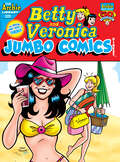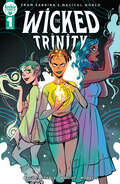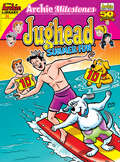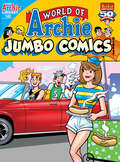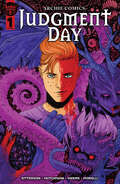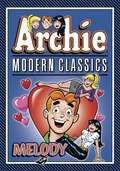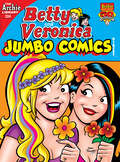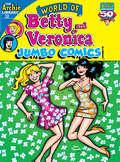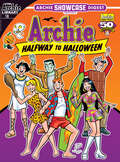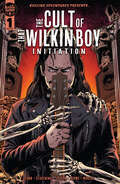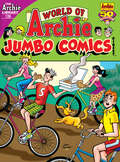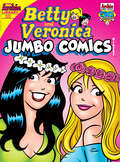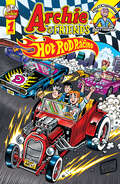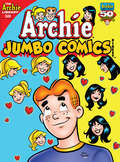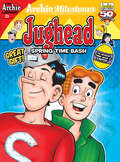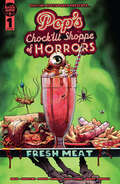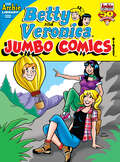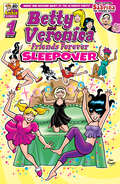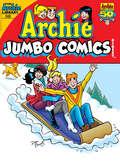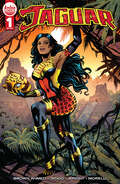- Table View
- List View
Betty & Veronica Double Digest #325 (Betty & Veronica Double Digest #325)
by Archie SuperstarsBRAND NEW STORY! Dr. Masters gives some befuddled citizens of Riverdale (Veronica, Betty, Archie, and Ethel) great dating advice that goes horribly and hilariously wrong in a series of short FlipFlop videos.
Archie Comics: Judgement Day #2 (Archie Horror Presents #2)
by Aubrey SittersonThe epic Archie Horror event continues, as does Archie’s quest. Jughead’s trying his best to act as Archie’s conscience and voice of reason, but with so many people once familiar and even beloved to Archie turning into demonic monstrosities, can Archie maintain his grip? Maybe if Jughead gets more people on his side, they can talk some sense into him—are Betty and Veronica up to the task of bringing back the Archie they know and love from Alistair’s grasp?
Archie Double Digest #351 (Archie Double Digest #351)
by Archie SuperstarsBRAND NEW STORY! Move over, Scooby Doo, the new mystery-solving team is here. Fran Frazer (and introducing her crime-fighting cat Stinger) is on the case with Archie and friends. Can they save the old beach theme park, or will they be scaredy cats?
The Wicked Trinity (Archie Comics Presents #1)
by Sam MaggsSabrina’s magical nemesis Amber Nightstone and her sidekicks, Jade Kazane and Sapphire Gill, are intent on becoming the most powerful witches in the world. Isolated from so many around them, the three have formed a coven based on their individual needs for vengeance and true freedom. But when there is some dissent among the ranks, their small coven is threatened to be obliterated from within.
World of Betty & Veronica Double Digest #33 (World of Betty & Veronica Digest #33)
by Archie SuperstarsBRAND NEW STORY! Betty and Veronica will do anything to get the attention of heartthrob Dr. Masters while he is filming his new medical series on Riverdale Beach. It’s the battle at the beach with Betty vs Veronica.
Archie & Friends: Blockbuster Movies (Archie & Friends #1)
by Archie SuperstarsBRAND NEW STORY: Archie’s summer movie fantasies get out of control! You’ve heard of Deadpool! Well, get ready for PoolNoodle! A character whose first appearance may be his last! Archie and the gang poke fun at every movie you can shake a stick at or sword. But no blood in this issue, unless it’s a paper cut.
Archie Milestones Digest #24: Jughead Summer Fun (Archie Milestones Digest #24)
by Archie SuperstarsJoin Jughead for a crave case of tasty tales filled with picnic parties, BBQ bashes, and tons more to satisfy your hunger for humor in this milestone collection!
World of Archie Double Digest #140 (World of Archie Digest #140)
by Archie SuperstarsBRAND NEW STORY! It’s the first annual Riverdale Amateur Wrestling Rumble, a royal rumble for charity. No one can beat the masked wrestlers. Who is this mystery trio? And can they be beat?
Archie Comics: Judgment Day #1 (Archie Horror Presents #1)
by Aubrey SittersonIn a world overrun with demons, Archie Andrews is on a quest to cleanse Riverdale of all wicked-kind. Harnessing the destructive power of a captive fiend, he will have to destroy corrupted and possessed versions of the people closest to him. Questioning his own morality and forced to make difficult sacrifices, are Archie’s efforts truly good, or the work of pure evil? Traverse the most horrifying version of Riverdale yet in the first Archie Premium Event.
Archie: Modern Classics Melody (Archie Graphic Novels #1)
by Archie SuperstarsAfter 80 years of humorous tales, the Riverdale gang are still going strong! Archie is proud to present a symphony of ALL NEW stories so far from the last year of digest comics—collected for the first time ever. Don’t miss these modern classics!
Betty & Veronica Double Digest #324 (Betty & Veronica Double Digest #324)
by Archie SuperstarsBRAND NEW STORY! Veronica wants to prove Powerteen is the best superhero, but will dooming Riverdale really do the trick?
World of Betty & Veronica Double Digest #32 (World of Betty & Veronica Digest #32)
by Archie SuperstarsBRAND NEW STORY! Jaguar and Jughead are being held by a group of super-power squashing gangsters! Can Superteen and Powerteen rescue them without their powers?
Archie Showcase Digest #18: Halfway to Halloween (Archie Showcase Digest #18)
by Archie SuperstarsWe’re at the halfway point to Halloween, so grab your trick or treat bags, don your costumes, and get ready for a graveyard smash with these stories of costumes, ghosts, and more spooky fun tales!
The Cult of The Wilkin Boy: Initiation (One Shot) (Archie Horror Presents #1)
by Cullen BunnReturning to the world of last year’s successful THE CULT OF THAT WILKIN BOY, Bingo is now a music manager—and the devil incarnate. He’s initiating others by exchanging their souls for stardom. But is this what he really wants out of life? Is this what he worked so hard for? Bingo embarks on a quest to return to his first love: performing music. But the road back to superstardom isn’t going to be an easy one, and it’s going to take a lot of souls to get there.
World of Archie Double Digest #139 (World of Archie Digest #139)
by Archie SuperstarsBRAND NEW STORY! What is life with Archie really like? Find out from the unique perspectives of those closest to him in this unique and entertaining story!
Betty & Veronica Double Digest #323 (Betty & Veronica Double Digest #323)
by Archie SuperstarsTWO BRAND NEW STORIES! First, someone has kidnapped Dr. Masters for ransom! Betty, Veronica, and all the girls of Riverdale team up to find him. Can they solve the case? Then, newly famous rocker Bingo Wilkin can’t perform without his lucky dog Rebel, so it’s up to Betty, Veronica, and Jola of Rock Candi to find his beagle and get both their bands on stage before the curtains open!
Archie & Friends: Hot Rod Racing (Archie & Friends #1)
by Archie SuperstarsA BRAND-NEW STORY kicks off this NEED FOR SPEED issue! In “The Race to Save Face,” the first appearance of Daisy Thunder of the Southside Serpents, Daisy challenges Archie and his crew to a charity race throughout the Riverdale. Can Archie prove that his souped-up jalopy can best Daisy’s hot wheels? All that plus more racing fun!
Archie Double Digest #349 (Archie Double Digest #349)
by Archie SuperstarsBRAND NEW STORY! ARCHIE has been selected as the first human high school student to attend a prestigious outer space high school! What will life… more importantly high school life… be like in outer space?
Archie Milestones Digest #23: Jughead Spring Time Bash (Archie Milestones Digest #22)
by Archie SuperstarsSpring is in the air, so smell the flowers (and burgers!) with Jughead in this collection of seasonal stories featuring everyone’s favorite best pal!
Pop's Chock'lit Shoppe of Horrors: Fresh Meat (One-Shot) (Archie Horror Presents #1)
by Amy ChasePop’s Chock’lit Shoppe has been around for what feels like forever… but how? In this thrilling horror anthology, we learn just how Pop’s infamous malt shop came to harbor such evils, and the cursed deals he makes to ensure his doors always stay open. From the full creative team that brought you last year’s successful Pop’s Chock’lit Shoppe of Horrors, we learn the nefarious origin of the beloved hometown haunt, with stories filled with shady business deals, carnivorous plants, and the horrors of small business ownership.
World of Archie Double Digest #138 (World of Archie Digest #138)
by Archie SuperstarsBRAND NEW STORY! A big budget movie about The Shield is being filmed in Riverdale, and Archie and all his friends can’t wait to see it! But how does Joe Higgins, the man behind the Shield mask, feel about all this fanfare?
Betty & Veronica Double Digest #322 (Betty & Veronica Double Digest #322)
by Archie SuperstarsTWO BRAND NEW STORIES! First, someone has stolen a copy of Ms. Grundy’s semester final and it’s up to crime podcast host Fran Frazer—along with Betty & Veronica—to find out who took it and why. Then, after ice skating with the gang, Sabrina shares some hot cocoa her aunts made for her with everyone—little does she know it’s actually a potion to help her skate better! What happens when magic ends up in the wrong hands (or, in this case, feet!)?
B&V Friends Forever: Sleepover (B&V Friends Forever #22)
by Archie SuperstarsBRAND NEW STORY: Betty, Veronica, Sabrina, and a few friends are all having a sleepover at a cottage on the mysterious estate Alexander and Alexandra Cabot inherited. But when weird things beyond levitation and ghost stories start happening, Sabrina suspects magic is afoot! Plus, more stories of sleepover fun, including pillow fights, gossip, and plenty of cute pajamas!
Archie Double Digest #348 (Archie Double Digest #348)
by Archie SuperstarsTWO BRAND NEW STORIES! First, Bingo Wilkin’s new song has gone viral! Unfortunately, the song is so popular that Bingo can’t go out in public without being swarmed by fans. How will he manage to celebrate his anniversary with Samantha? Maybe Archie and Jughead can help! Then, Archie saves the day for Shield with the super-power of super-fandom!
The Jaguar (Mighty Crusaders (2021-))
by Keryl Brown AhmedSomething is killing the Pampas cats of Northern Peru. A group of zoologists has come together to investigate these mysterious slayings. They know the culprit is a bird of prey, but the method of killing is unlike any of the birds local to the region. It’s going to take someone with apex predator abilities to find out who’s causing these murders…someone like Ivette Velez, aka The Jaguar! But will the predator become the prey?
